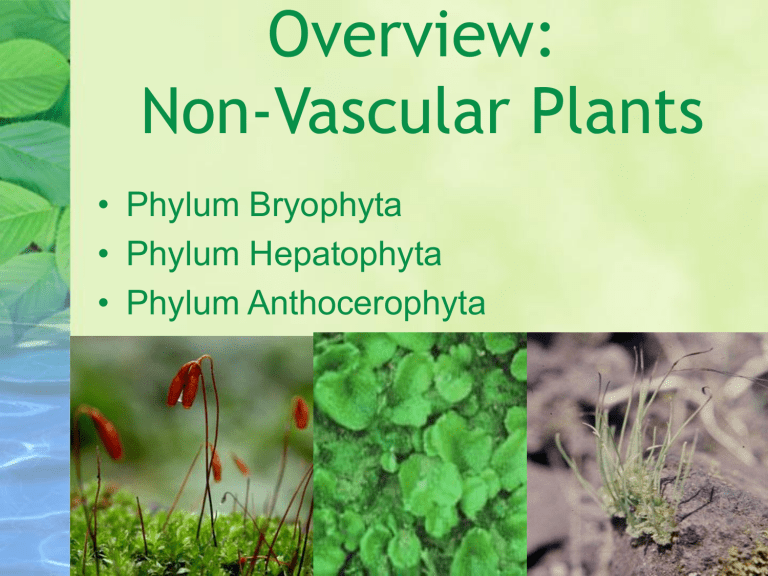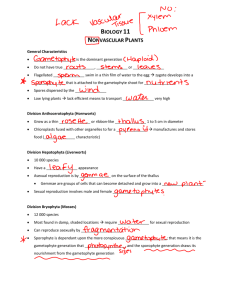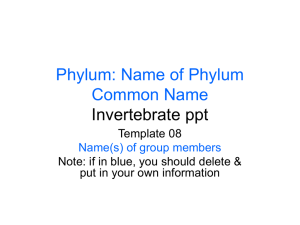Overview: Non-Vascular Plants • Phylum Bryophyta • Phylum Hepatophyta

Overview:
Non-Vascular Plants
• Phylum Bryophyta
• Phylum Hepatophyta
• Phylum Anthocerophyta
Phylum Bryophyta = the Mosses
Phylum Bryophyta = the Mosses
General characteristics:
• short plants
• no vascular system
• no “true” stems, roots, or leaves
• need constant water supply for survival
Phylum Bryophyta = the Mosses
Habitat
• wetlands, moist areas, areas with standing water
• Depend upon diffusion for transport of nutrients
• Require water for reproduction
Phylum Bryophyta = the Mosses
Reproduction
• Needs standing water for sperm to swim to eggs
• Alternation of generations: alternation between a gameophyte generation & a sporophyte generation
• Reproductive structures =
SPORES
(no seeds)
Moss sperm
Moss spores
Phylum Bryophyta = the Mosses
Structures:
• Capsule
/ Sporangium
• Sporophyte
• Gametophyte
• Rhizoids (root-like)
Phylum Bryophyta : examples
Sphagnum
• Function= retain water, improve soil
• e.g. aid in orchid cultivation
Phylum Bryophyta : examples
Plume moss
Phylum Bryophyta : examples
Common peat moss
• Used to improve soil water retention
Peat moss is a dead form of Sphagnum moss that grows in the North American taiga.
Phylum Bryophyta = the Mosses
Dominant generation of mosses = gametophyte this is the sporophyte
Phylum Hepatophyta
(Liverworts)
Phylum Hepatophyta
(Liverworts)
• short, flat plant
• no vascular system
• no “true” stems, roots, or leaves
• no stomata
• habitat= wetlands
• need standing water for sexual reproduction
(sperm swim to eggs)
• Dominant generation = gametophyte
Phylum Hepatophyta – examples
Marchantia
Phylum Hepatophyta – examples
Monoclea forsteri
Phylum Hepatophyta – examples
Assorted liverworts
Mosses vs. Liverworts
Phylum Anthocerophyta
Hornworts
Phylum Anthocerophyta
Hornworts
• short, flat plant
• no vascular system,
• no “true” stems, roots, or leaves
• sporophytes have stomata
• Habitat – wetlands
• Reproduction - standing water for sexual repro.
(sperm swim to eggs)
• Dominant generation= gametophyte



